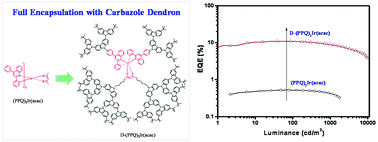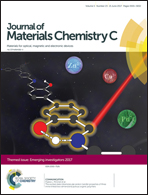An oligocarbazole-encapsulated heteroleptic red iridium complex for solution-processed nondoped phosphorescent organic light-emitting diodes with over 10% external quantum efficiency
Abstract
A novel self-host red Ir dendrimer D-(PPQ)2Ir(acac) has been developed for solution-processed nondoped phosphorescent organic light-emitting diodes (PhOLEDs) by fully encapsulating the heteroleptic complex (PPQ)2Ir(acac) with oligocarbazole at both the C∧N and O∧O ligands. Due to the shielding effect of the dendritic wedge, the intermolecular interactions and luminescence quenching are found to be significantly reduced from (PPQ)2Ir(acac) to D-(PPQ)2Ir(acac). Correspondingly, the maximum external quantum efficiency (EQE) of hybrid-solution-processed electrophosphorescent devices is increased from 0.5% to 9.9%. Moreover, D-(PPQ)2Ir(acac) shows a good alcohol resistance in the presence of the large-size carbazole dendrons. Such a feature does favor the successful fabrication of all-solution-processed devices via an orthogonal solvent processing, revealing an optimized EQE as high as 11.1% (8.7 cd A−1, 6.0 lm W−1) with CIE coordinates of (0.67, 0.33). The results indicate that highly efficient solution-processed red-emitting nondoped PhOLEDs with over 10% EQE can also be realized based on a self-host phosphorescent dendrimer system.

- This article is part of the themed collection: Journal of Materials Chemistry C Emerging Investigators


 Please wait while we load your content...
Please wait while we load your content...